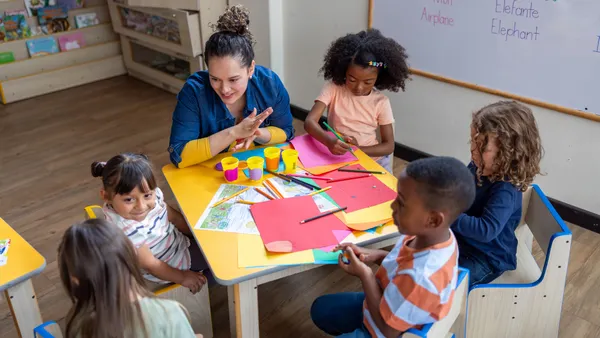Dive Brief:
- A recent report by the Center on Reinventing Public Education sounded the alarm on COVID-19's particular impact on older students — particularly those who are nearing graduation or have already graduated from high school — and how time is running out to help them catch up from learning loss after long-term school closures began in 2020.
- As signs of grade inflation and high school graduation rates go up, CRPE said, it’s “likely that many students leave the system unprepared for college and career.” The report cites more concerning data suggesting that student testing performance and enrollment in 4-year undergraduate programs have also dropped since COVID began.
- CRPE suggests that in order to improve the future course of older students, state and federal officials should provide transparent data regarding pandemic recovery. The report added that schools are in need of innovative approaches, like investing in national youth intervention strategies that tap into adult-student relationships and artificial intelligence technology.
Dive Insight:
Research has shown that more supports are still needed to help students across all grade levels return to pre-pandemic achievement levels.
In fact, the average student is estimated to require 4.1 additional months of reading instruction and 4.5 more months of math to catch up from COVID-19 learning loss, according to a July report from NWEA that analyzed the MAP Growth test scores of 6.7 million students from 20,000 public schools. Older students were also more likely to need even more time to recover, NWEA found.
Another barrier to student recovery progress is the increasing difficulty to get students to show up for class in the first place. The National Center for Education Statistics found that 72% of public schools reported an increase in chronic absenteeism compared to an average year before the pandemic.
This growth of chronic absenteeism between 2019-20 and 2020-21 has also contributed to a drop in post-pandemic test scores on the National Assessment of Educational Progress, according to the White House Council of Economic Advisers.
So what does that mean for older students who don’t have much time left in the K-12 school system to make up for lost instructional time?
Innovative approaches will be necessary to adjust to this new reality for older students, who are currently the most at risk to lag behind in college and career success, the CRPE report noted. Other creative strategies to help older students adapt to a post-K-12 environment can include policies that encourage transition or gap years between high school and college or a career, according to CRPE.
“Taking a break from college to support family or address mental health issues should not permanently jeopardize a student’s chance of earning a credential,” the report wrote.
For instance, CRPE suggests community colleges could offer a tuition-free gap year program via state and federal grants that allow students to complete their high school degree and start earning college credits or industry certifications.
Overall, education leaders will have to rethink high-school-to-career pathways, the report added.
“We need to go beyond pilots for more career-relevant high schools that blur the lines among high school, college, and career,” the report said. “We will simply tinker around the edges of what students need and want if we fail to reimagine American high schools as more engaging, joyful, equitable, and relevant to college and career.”










